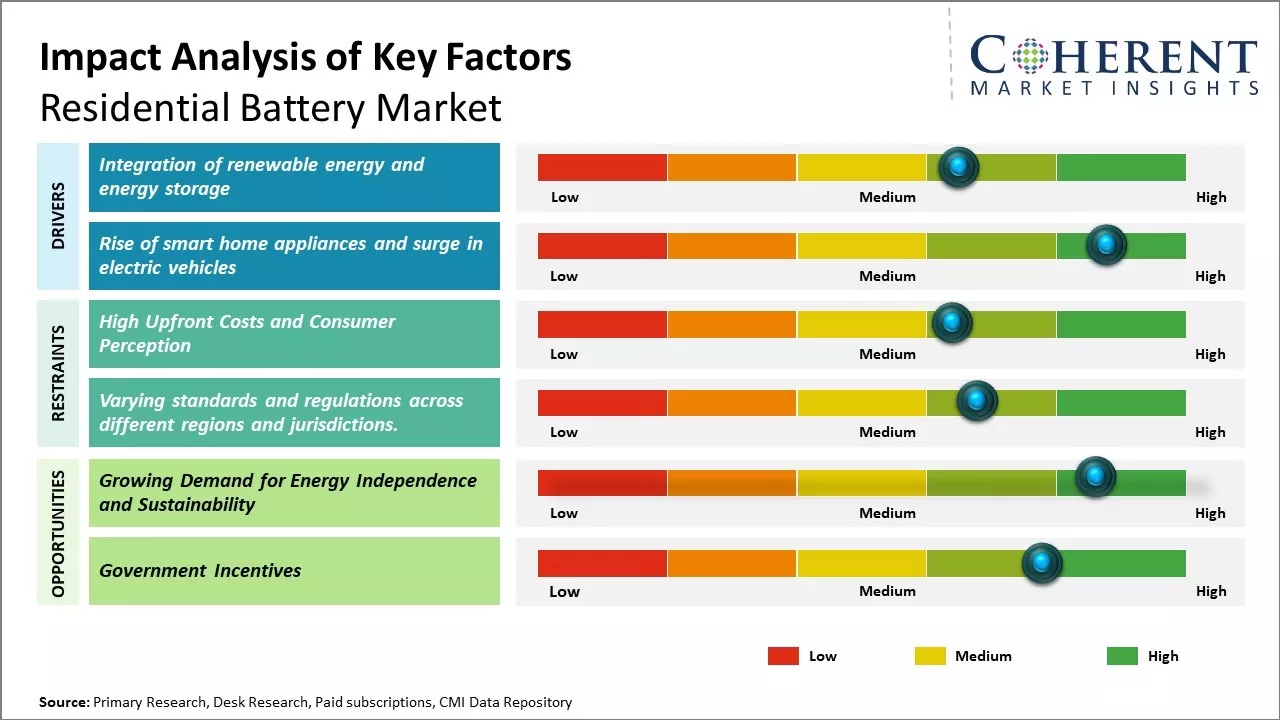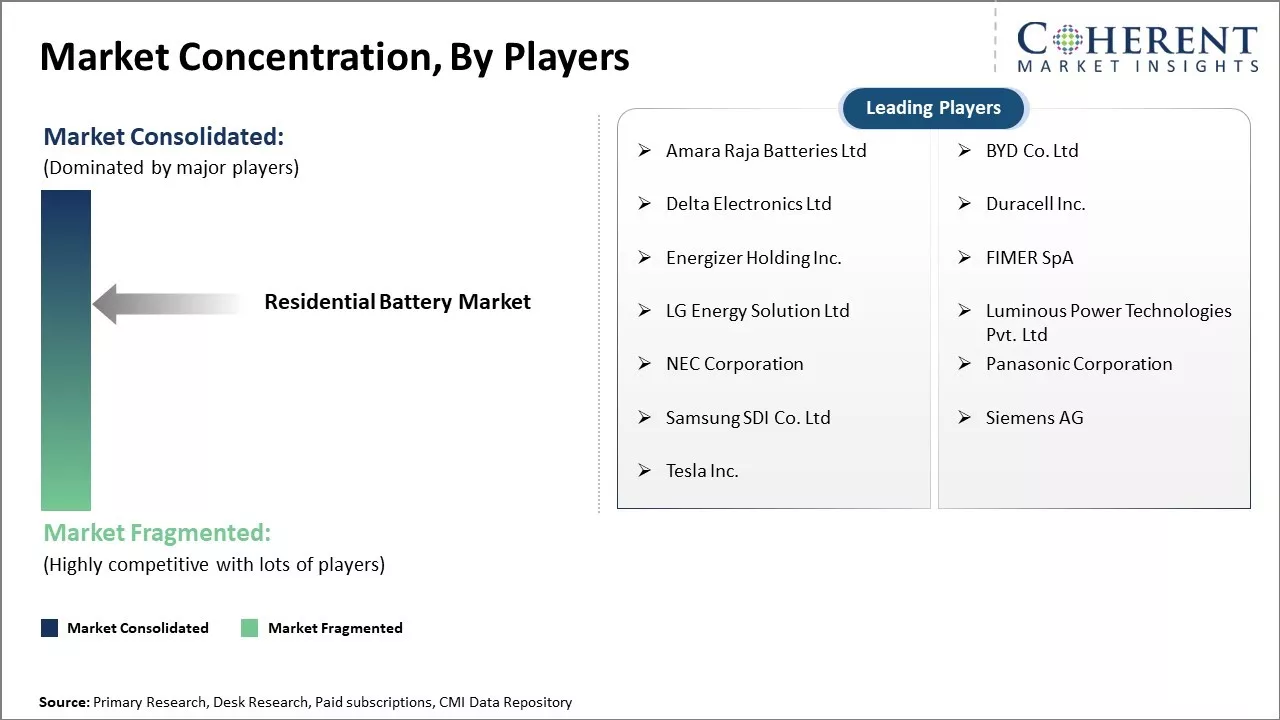The residential battery market is estimated to be valued at USD 14.35 Bn in 2025 and is expected to reach USD 47.12 Bn by 2032, growing at a compound annual growth rate (CAGR) of 18.5% from 2025 to 2032.

To learn more about this report, Download Free Sample
The residential battery market demand is driven by the increasing demand for green energy and grid stability. Rising electricity costs and growing awareness among homeowners regarding energy independence is also pushing the growth of localized and distributed energy storage solutions. Government regulations and policies providing incentives for battery storage installations are further encouraging the widespread adoption of residential battery systems. The deployment of residential batteries is expected to pick up pace over the coming years as their prices continue to decline and technologies improve.
|
Current Event |
Description and its Impact |
|
Manufacturing and Infrastructure Development |
|
|
Technological Advancements |
|
Uncover macros and micros vetted on 75+ parameters: Get instant access to report
AI is playing an increasingly important role in the residential battery market by enhancing the efficiency, coordination, and integration of energy storage systems. For example, in April 2025, US-based EcoFlow launched the Stream series, a second-generation balcony solar system that replaced its PowerStream line. This new battery-centric design leverages AI to coordinate multiple units seamlessly, improve integration, and ensure compatibility with third-party devices. This allows batteries to be AC-connected inside apartments while synchronizing with the balcony solar setup, optimizing energy use and storage across the home.
The cost of residential battery systems varies based on capacity, brand, and region. Typical price ranges are:
In terms of type, lithium-ion battery is expected to contribute the highest share of 67.6% in 2025, owing to its superior energy density and cost advantage over other battery types. Lithium-ion batteries are able to store more energy per unit weight and volume, which allows residential battery systems using lithium-ion batteries to be smaller and lighter than those using lead-acid batteries.
Additionally, the falling production costs of lithium-ion batteries in recent years have improved their cost competitiveness significantly. Manufacturers are achieving scale economies by building large battery manufacturing plants. There is also continuous technological progress that enhances energy density while reducing material usage. These factors have lowered the levelized cost of energy from lithium-ion batteries to a level that is attractive for residential applications. For consumers, lithium-ion battery systems mean lower upfront capital costs compared to alternatives.
In June 2025, Neuron Energy launched its Gen 2 lithium-ion battery packs for electric two‑wheelers, three‑wheelers, and light commercial vehicles (LCVs). The upgraded series features reinforced architecture, advanced thermal management, and enhanced vibration resistance tailored to India’s challenging road conditions. A smarter Battery Management System (BMS) ensures improved cell balancing, extended battery life, and reduced maintenance.
In terms of by power output, the 6-10 kW segment is expected to contribute the highest share of 42.75% in 2025, as it offers an optimal balance between cost and application versatility. Batteries in the 6-10 kW range can effectively store excess solar power generated during the day and provide enough electricity in the evenings to power essential home appliances and lights. They offer sufficient capacity for most single-family homes.
At the same time, mid-range batteries allow economies of scale in manufacturing while having per-unit costs comparable to higher-capacity systems. They provide flexibility to later increase storage size to meet growing energy demands from electric vehicles or additional solar panels. Their flexibility makes them suitable for both new homes as well as retrofits in existing homes.
In terms of by operation type, standalone systems are expected to hold the highest share of 72.42% in 2025, as they provide a cost-effective means for residential consumers to take full control of their energy needs. Standalone batteries are an affordable solution for homes not connected to the main power grid or for those aiming to achieve energy self-sufficiency.
They allow for independent power during outages and offer insurance against rising electricity tariffs. In remote locations lacking grid access, standalone systems have become a dependable and clean alternative to diesel generators. An evolving range of power conversion equipment further boosts their efficacy. Additionally, latest standalone batteries have achieved parity on levelized cost of energy with grid power in some nations, making them a compelling investment. Their modularity also means easy DIY installation and scalability based on load changes. This furthers the appeal of independence from centralized infrastructure.
In May 2025, India launched South Asia’s first utility‑scale standalone battery energy storage system (BESS) in Delhi’s Kilokari substation. It aims to stabilize the grid, manage peak demand, and power over 12,000 low-income consumers, offering four hours of daily reliable power.

To learn more about this report, Download Free Sample
The Asia Pacific region is poised to be the fastest growing with CAGR of 24.0% as well as dominant market with market share of 43.7% for residential batteries market in 2025. With increasing electrification across countries and rapid expansion of distributed renewable energy sources, the need for residential storage assets is rising greatly. The region hosts a few emerging battery hubs like China, South Korea, Japan, and India which are helping augment the manufacturing capabilities and supply chain requirements. Battery majors have been rapidly scaling up their localized production to cater to the ballooning regional demand. Projects involving microgrids and rural electrification relying on battery storage are further driving the APAC market.
Countries like Australia and New Zealand within the Asia Pacific region have also emerged as promising markets, though from a smaller base. Growing distributed generation incentivized by net metering and feed-in-tariff schemes have accelerated the adoption of household batteries. Battery installations are largely concentrated in off-grid rural communities and island regions that look to integrate more renewables into their energy mix. Residential battery suppliers have started exploring these countries through partnerships with local EPC players and retailers. This is further supporting the residential battery market share.
Germany residential battery market is characterized by policy support, high solar penetration, energy independence goals, and public awareness of climate change. Germany has one of the highest rates of rooftop solar installations in Europe. To maximize solar self-consumption and reduce reliance on the grid, households are increasingly pairing solar panels with battery storage. As part of its Energiewende, or energy transition policy, Germany is phasing out coal and nuclear power. This decentralization of energy production encourages homeowners to become “prosumers” (producers + consumers), using batteries to store and manage their own energy.
Germany offers federal and regional subsidies for home battery systems. For instance, states like Bavaria and North Rhine-Westphalia have launched funding programs to support battery purchases and installations, making systems more accessible. For instance, in 2022, Germany installed approximately 220,000 new residential batteries, totaling a combined capacity of 1.2 GW and 1.9 GWh, representing a 52% increase compared to 2021.
Japan residential battery is rapidly evolving, fueled by expanding energy security concerns, frequent natural disasters, and proactive government support for renewable energy and smart home technologies. Japan significantly reduced its reliance on nuclear power and shifted toward decentralized, renewable energy sources like solar. This created a strong need for backup power solutions in homes. Residential batteries allow homeowners to store solar energy and maintain electricity during grid outages, a feature that has become especially important in a country prone to earthquakes, typhoons, and tsunamis.
Japan has one of the highest numbers of rooftop solar installations per capita. With limited land area and high population density, decentralized solar systems paired with home energy storage have become a practical solution. For instance, in September 2024, ENERES launched a demonstration project to test remote control and dispatch of residential energy storage systems. Japan is installing several megawatt-hours of home battery storage, often paired with solar PV, every month. This is further accelerating the residential battery market demand.
The U.S. continues to lead in the residential battery market due to its environmental, economic, and infrastructure-related factors. The United States experiences frequent power outages due to extreme weather events (like hurricanes, wildfires, and heatwaves), particularly in states such as California, Texas, and Florida, have increased consumer interest in home energy storage. Residential batteries provide backup power during blackouts, improving energy security and peace of mind. Apart from this, federal programs like the Investment Tax Credit (ITC), which offers a tax deduction of up to 30% on home battery system costs (especially when paired with solar), have made residential storage more affordable. In addition, some states offer rebates and grants to promote battery adoption (e.g., California’s SGIP program).
Australia residential battery market is growing swiftly as the country experiences high solar usage, energy cost pressures, resilience needs, and government support makes it a global leader in residential battery demand. Australia has one of the highest rates of rooftop solar installation per capita in the world. Over 3.6 million households have solar panels as of 2025. With such widespread solar penetration, residential batteries are becoming essential for storing excess daytime energy and using it at night, reducing grid dependence and increasing energy self-sufficiency. Households in Australia face some of the highest electricity costs globally. Residential batteries offer a way to offset peak-time electricity charges by allowing consumers to store cheap solar or off-peak grid energy and use it when prices are highest.

To learn more about this report, Download Free Sample
| Report Coverage | Details | ||
|---|---|---|---|
| Base Year: | 2024 | Market Size in 2025: | USD 14.35 Bn |
| Historical Data for: | 2020 To 2024 | Forecast Period: | 2025 To 2032 |
| Forecast Period 2025 to 2032 CAGR: | 18.5% | 2032 Value Projection: | USD 47.12 Bn |
| Geographies covered: |
|
||
| Segments covered: |
|
||
| Companies covered: |
Amara Raja Batteries Ltd, BYD Co. Ltd, Delta Electronics Ltd, Duracell Inc., Energizer Holding Inc., FIMER SpA, LG Energy Solution Ltd, Luminous Power Technologies Pvt. Ltd, NEC Corporation, Panasonic Corporation, Samsung SDI Co. Ltd, Siemens AG, and Tesla Inc. |
||
| Growth Drivers: |
|
||
| Restraints & Challenges: |
|
||
Uncover macros and micros vetted on 75+ parameters: Get instant access to report
With growing environmental concerns and emphasis on sustainability, many countries have set ambitious renewable energy targets to transition towards cleaner sources of energy like solar and wind. Due to the intermittent nature of these renewable sources, the need for scalable and reliable energy storage to balance power fluctuations is growing. Residential battery storage absorbs excess renewable energy produced during the day, discharging it to power homes in the evening. This helps homeowners lower their carbon footprint and electricity bills by maximizing the self-consumption of on-site clean energy. Moreover, by reducing dependency on the grid during peak hours, battery storage also helps reduce stress on the overall power infrastructure. Several governments now offer substantial subsidies and tax incentives for homeowners to install rooftop solar panels integrated with battery packs. This has encouraged many environmentally conscious consumers to opt for such green home energy solutions.
The growing demand for energy independence and sustainability is significantly shaping the trajectory of the residential battery market, particularly as homeowners seek reliable, clean, and cost-effective energy solutions. Rising electricity prices, frequent grid outages, and increased awareness of climate change have fueled a shift toward decentralized energy systems. As a result, more households are adopting have fueled a shift toward decentralized energy systems. As a result, more households are adopting solar-plus-storage systems, where residential batteries store excess solar energy for use during the night or emergencies, reducing dependence on the conventional grid. For instance, according to an article published by Solar Energy Industries Association, in 2024, more than 28% of new residential solar installations included storage, up from less than 12% in 2023.
The residential battery market value stands at a pivotal inflection point, both technologically and strategically. The narrative has evolved beyond mere energy storage to one of energy independence, resilience, and grid decentralization. While the macro-level drivers such as rising electricity tariffs and transition to renewables remain foundational, the micro-trends now shaping the market are decisively consumer-centric and policy-aware.
To begin with, there is a quiet but decisive shift toward hybrid and modular systems that offer dynamic flexibility. Companies like Sonnen and Enphase are no longer just providing lithium-ion batteries, they're integrating load shifting, time-of-use optimization, and blackout protection within AI-enabled platforms. In Germany, nearly 1 in 2 new solar installations are now sold with a residential battery, a figure that underscores the speed of adoption when economic and policy frameworks align.
Furthermore, the value of battery storage is increasingly decoupled from solar. For instance, in California, the introduction of NEM 3.0 slashed export compensation rates, compelling households to self-consume solar energy rather than export it. As a direct result, residential battery attachment rates surged from 11% in 2022 to over 30% by late 2023. This illustrates a fundamental market truth: battery adoption is not a derivative of solar anymore, it is a hedge against volatile grid economics.
However, the real differentiator in the coming years will be battery intelligence. Companies that can algorithmically integrate real-time weather forecasts, occupancy behavior, and energy pricing to optimize storage use will unlock margin-rich services such as energy arbitrage and virtual power plant (VPP) participation. Tesla’s Powerwall, aggregated through the Autobidder platform, has already proven this with its enrollment in VPP schemes across Australia and the U.S. Northeast.
Share
Share
About Author
As an accomplished Senior Consultant with 7+ years of experience, Pooja Tayade has a proven track record in devising and implementing data and strategy consulting across various industries. She specializes in market research, competitive analysis, primary insights, and market estimation. She excels in strategic advisory, delivering data-driven insights to help clients navigate market complexities, optimize entry strategies, and achieve sustainable growth.
Missing comfort of reading report in your local language? Find your preferred language :
Transform your Strategy with Exclusive Trending Reports :
Frequently Asked Questions
Joining thousands of companies around the world committed to making the Excellent Business Solutions.
View All Our Clients